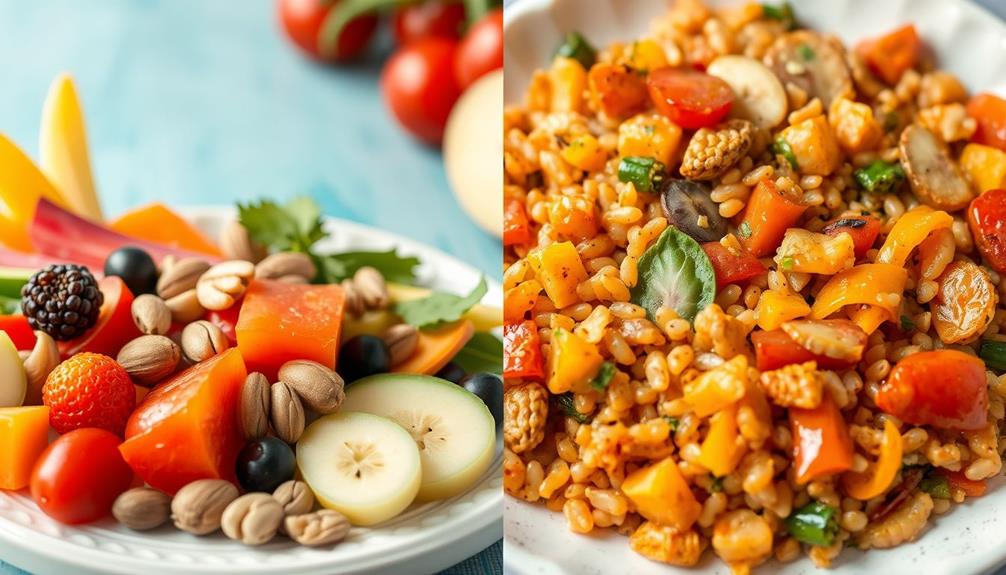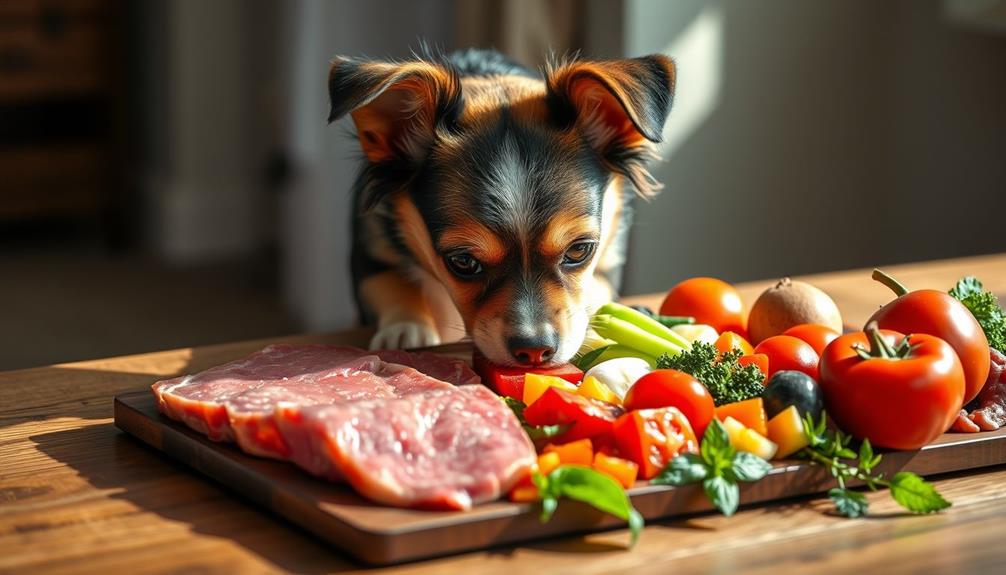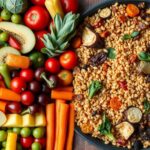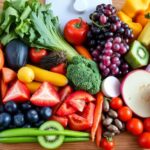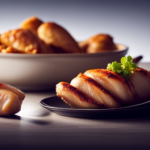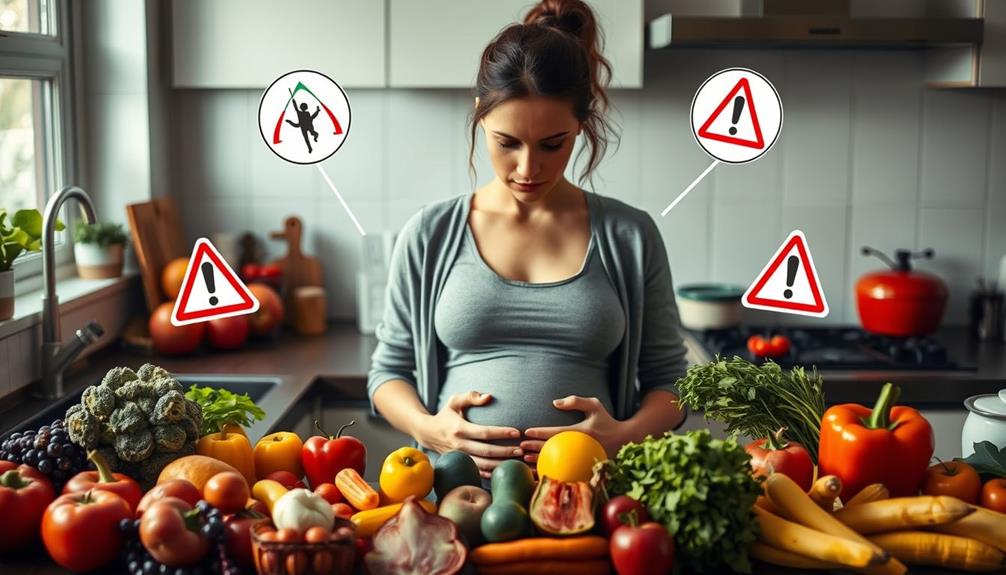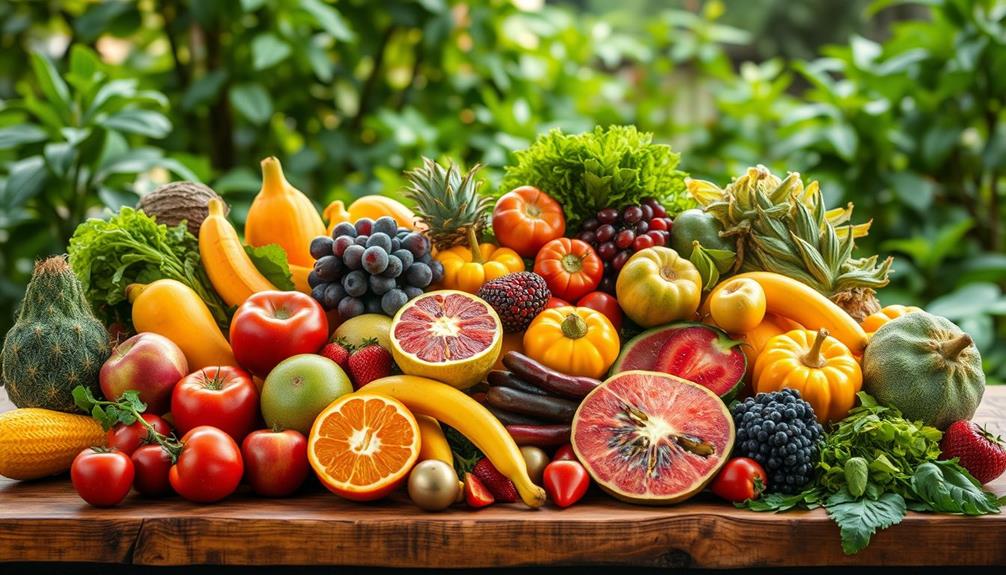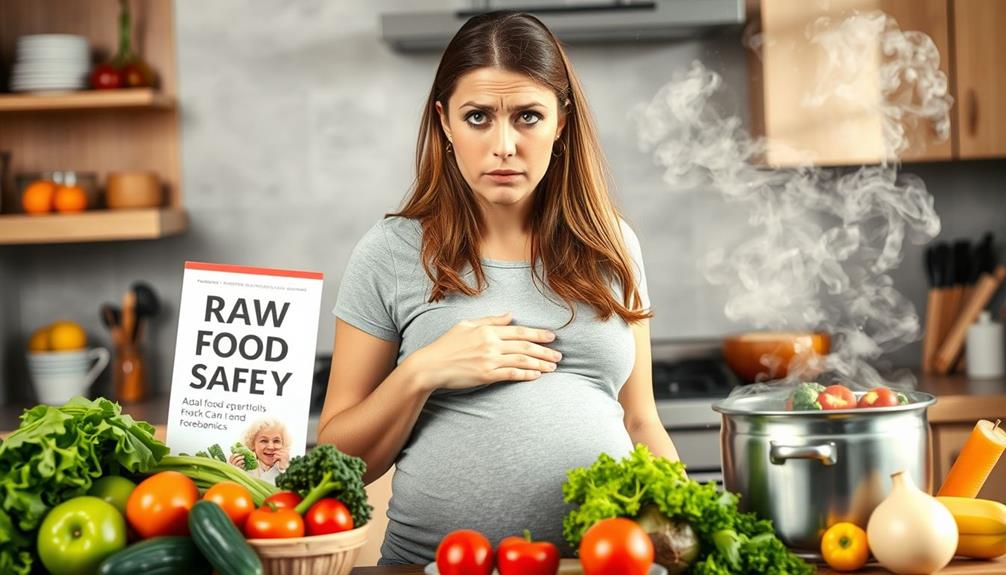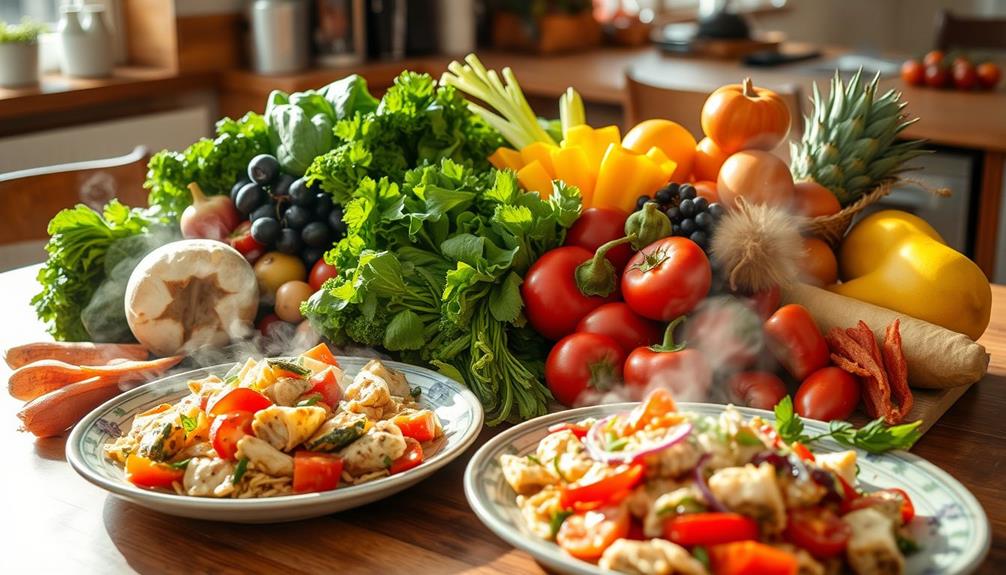Raw food usually has fewer calories than cooked food. When you cook, it enhances digestibility, allowing your body to extract more energy from the nutrients. For instance, a raw chicken breast has about 136 calories per 100g, while fried chicken might contain 312 calories for the same weight. Cooking also modifies the food structure, making it easier for your gut to absorb nutrients, which means you get more calories efficiently. Plus, cooking techniques like frying can greatly boost calorie counts. If you're curious about how different foods stack up, there's plenty more to uncover. Understanding the difference between raw and cooked foods can be important for those trying to manage their calorie intake. While raw food may have fewer calories, the cooking process can actually make certain nutrients more available to our bodies. This means that the calorie count of a food item can vary greatly depending on whether it is raw or cooked. It’s important to consider this when planning meals and trying to maintain a balanced diet.
Key Takeaways
- Raw food often has lower caloric absorption due to the energy required for digestion, compared to cooked food which enhances digestibility.
- Cooking methods like frying significantly increase the caloric density of food, as seen with fried chicken versus raw chicken.
- While raw foods might have lower calories, cooking allows for more complete metabolism of nutrients, leading to higher energy extraction.
- Quality of calories is essential; whole foods offer more nutrients than raw or processed options, impacting overall health.
- Personalized nutrition approaches are emerging, focusing on how individuals metabolize calories from cooked versus raw foods.
Historical Context of Caloric Measurement
Throughout history, the measurement of calories has evolved considerably, shaping our understanding of nutrition. The traditional caloric measurement system, established by Wilbur Atwater in the early 1900s, assigned specific calorie counts: 4 calories per gram of protein, 9 for fat, and 4 for carbohydrates.
However, this system has faced criticism for its inaccuracies. You might be surprised to learn that current assessments often overlook the energy your body expends during digestion, leading to potential miscalculations in your caloric intake. Additionally, understanding concepts like budgeting can help manage dietary choices effectively.
In fact, some research indicates a significant underestimation of caloric intake, with discrepancies of up to 20% between labeled and actual caloric values. This has prompted countries like Australia to move away from outdated systems, recognizing the inaccuracies in caloric labeling.
The limitations of Atwater's system have sparked calls for updates, especially regarding how we measure energy absorption from both cooked and raw food. Understanding these historical contexts is essential, as it helps you appreciate the ongoing debates about whether cooked food has more calories than raw.
As science advances, so too will our grasp of what calories truly mean for our diets.
Impact of Cooking on Caloric Content
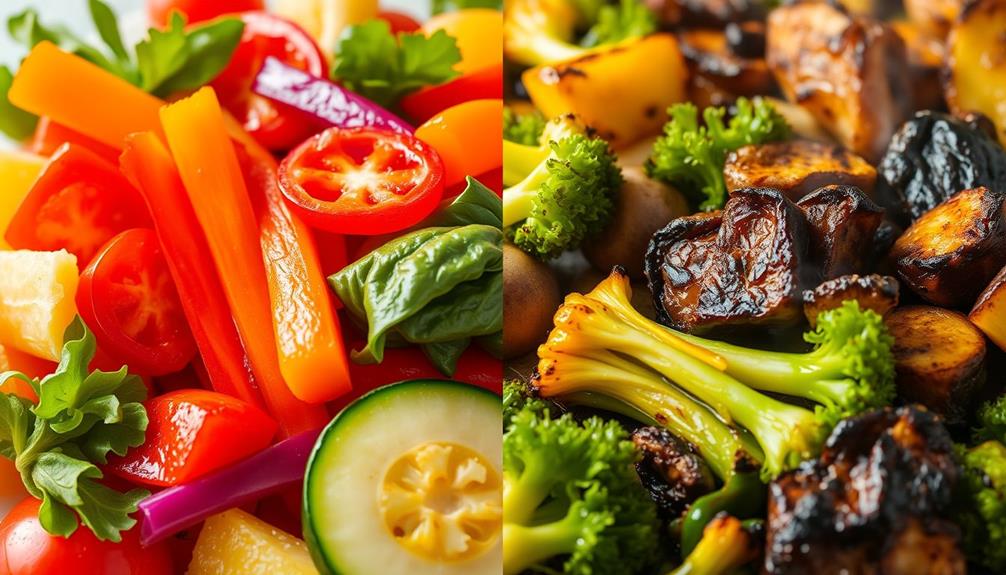
Cooking considerably alters the caloric content of food, often making it more energy-dense and easier for your body to absorb. Here are three ways cooking impacts caloric content:
1. Increased Digestibility: Cooking breaks down proteins and fats, allowing your body to extract more energy compared to raw food. For instance, raw chicken breast has about 136 calories per 100 grams, but frying it can yield around 312 calories due to added fats and improved digestibility.
Additionally, certain cooking methods can enhance the bioavailability of nutrients, similar to how essential oils for respiratory health can support overall well-being.
2. Enhanced Flavor: The Maillard reaction during cooking not only enhances flavor but can also lead to increased consumption, which contributes to higher overall caloric intake. When food tastes better, you're likely to eat more.
3. Cooking Methods Matter: Different cooking methods affect caloric density. While frying increases calories markedly with added oils, methods like boiling or baking typically maintain lower caloric counts, allowing you to enjoy cooked foods without excessive calorie intake.
Gut Bacteria and Caloric Absorption
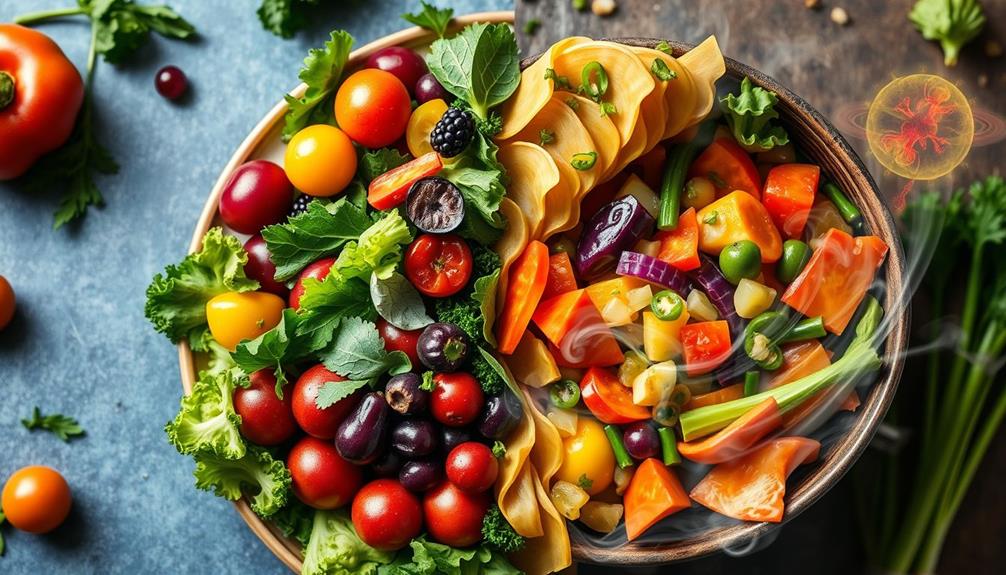
Understanding how gut bacteria influence caloric absorption reveals a fascinating aspect of nutrition. When you consume raw foods, your body requires more energy for digestion, leading to lower caloric absorption compared to cooked food. Cooking alters food's structure, making it easier for digestive enzymes to break down, which enhances energy extraction and absorption efficiency.
| Food Type | Energy Needed for Digestion | Caloric Absorption Efficiency |
|---|---|---|
| Raw Food | Higher | Lower |
| Cooked Food | Lower | Higher |
| Gut Bacteria | Varies | Influences absorption |
Research shows that raw food leaves more energy available for gut bacteria, which can consume a significant portion of this energy, ultimately reducing what you absorb. On the other hand, cooking externalizes part of the digestive effort, allowing for nearly complete metabolism of nutrients before reaching the large intestine, enhancing caloric availability. Additionally, the composition of gut bacteria varies based on your diet, with different communities responding uniquely to the types of food you consume, further influencing caloric absorption.
Quality of Calories in Diet
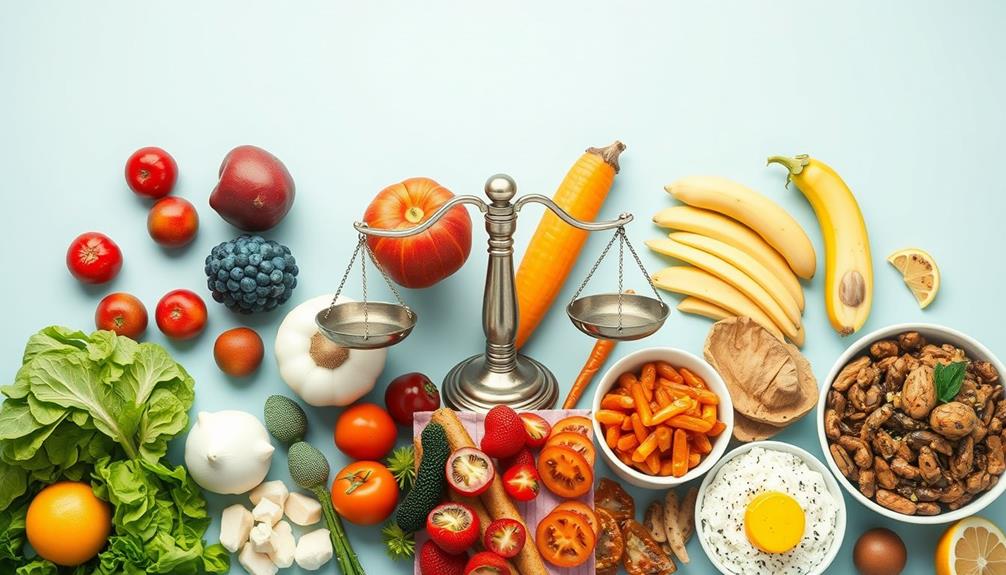
While many people focus solely on calorie counts, the quality of those calories plays an essential role in your overall health. It's important to acknowledge that not all calories are created equal. Here are three key points to take into account:
1. Nutrient Density: Whole foods like fruits and vegetables pack more vitamins and minerals compared to processed foods, which often lack essential nutrients despite similar calorie counts.
Furthermore, understanding the mechanics of how brewing methods affect caffeine content can help you make more informed choices about your beverages.
2. Caloric Absorption: Cooking can enhance the digestibility of foods, meaning you may absorb more calories from cooked meat than from raw alternatives, impacting your overall energy intake.
3. Satiety and Weight Loss: Foods rich in healthy fats, such as avocados and nuts, offer higher calorie content but also promote satiety, helping you manage your appetite better than empty-calorie processed snacks.
Future of Caloric Assessment
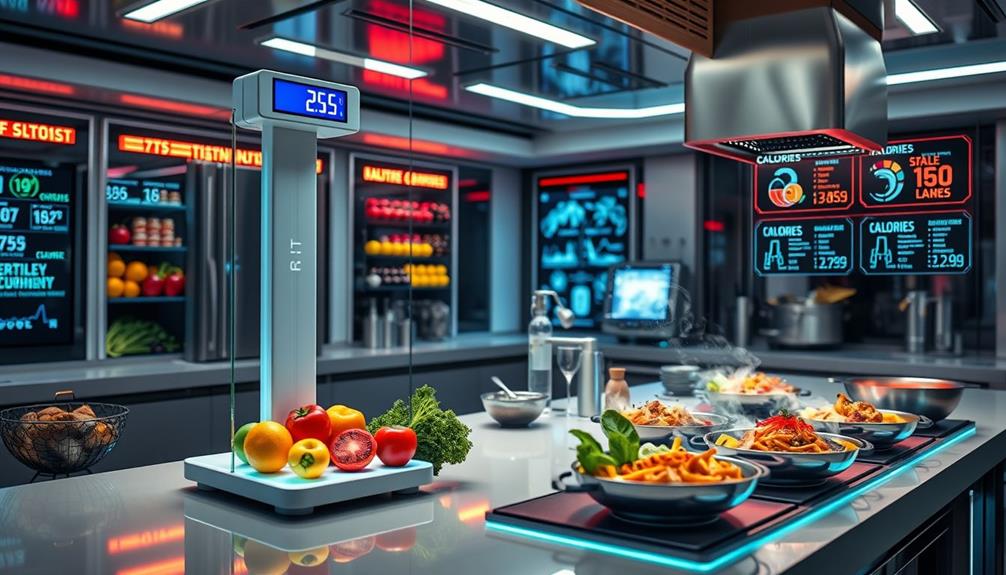
As technology increasingly advances, the future of caloric assessment is set to become more precise and reliable. You can expect standardized food databases to emerge, enhancing the reliability of caloric content measurements. Collaborations between scientists and the food industry will be essential in refining caloric counting methods, ensuring that your dietary choices are backed by accurate information.
In addition, understanding the effects of natural remedies alongside conventional medications will play a role in holistic health approaches. Ongoing research reveals significant variations in caloric content across different food types, highlighting the need for continuous improvement in measurement systems. New methodologies are being explored to address the inaccuracies of traditional systems, like the Atwater system, which often overlooks the energy used in digestion and by gut bacteria.
As these advancements unfold, personalized nutrition will take center stage. You'll benefit from tailored dietary recommendations that consider not just the calories you consume, but how your body processes those calories.
The integration of improved scientific understanding with technological innovations aims to provide you with more precise caloric information, ultimately supporting better public health initiatives. With these changes, you can look forward to a future where caloric assessments aren't only more accurate but also more aligned with individual needs.
Frequently Asked Questions
Which Has More Calories Cooked or Raw?
When you compare cooked and raw foods, you'll often find cooked options have more calories. Cooking breaks down structures, enhances flavors, and makes nutrients easier for your body to absorb, leading to increased caloric intake.
Should I Count Calories Raw or Cooked?
"You are what you eat." When counting calories, you should always track them based on how you prepare your food. Cooking alters caloric density, so focus on the cooked values for accuracy in your intake.
Do Calories Change From Raw to Cooked?
Yes, calories do change from raw to cooked. Cooking often increases the caloric availability of food, making nutrients easier for your body to absorb, which can lead to a higher calorie count in cooked items. For example, raw food calorie content may list a certain amount of calories, but once the food is cooked, the calories can increase due to the breakdown of cell walls and other changes in the food’s structure. This is why it’s important to consider both raw and cooked calorie counts when tracking your intake, especially if you are trying to manage your weight or adhere to a specific dietary plan. Keep in mind that the difference in calorie content between raw and cooked food can vary depending on the cooking method used.
Is It Healthier to Eat Foods Raw or Cooked?
Imagine a vibrant garden, where raw foods burst with life, offering freshness and enzymes. Cooked meals transform, releasing warmth and energy. Your choice depends on personal needs—balance both for ideal health and nourishment, like sunlight and shade.
Conclusion
In the grand culinary dance between raw and cooked foods, you might find that cooking reveals hidden treasures of calories, much like fire transformed early human diets. While raw foods boast vibrant nutrients, cooking enhances digestibility, letting your gut absorb more energy. So, as you choose your meals, remember that it's not just about counting calories; it's about savoring the journey they take from the plate to your body, fueling your adventures like a well-stocked ship setting sail.

